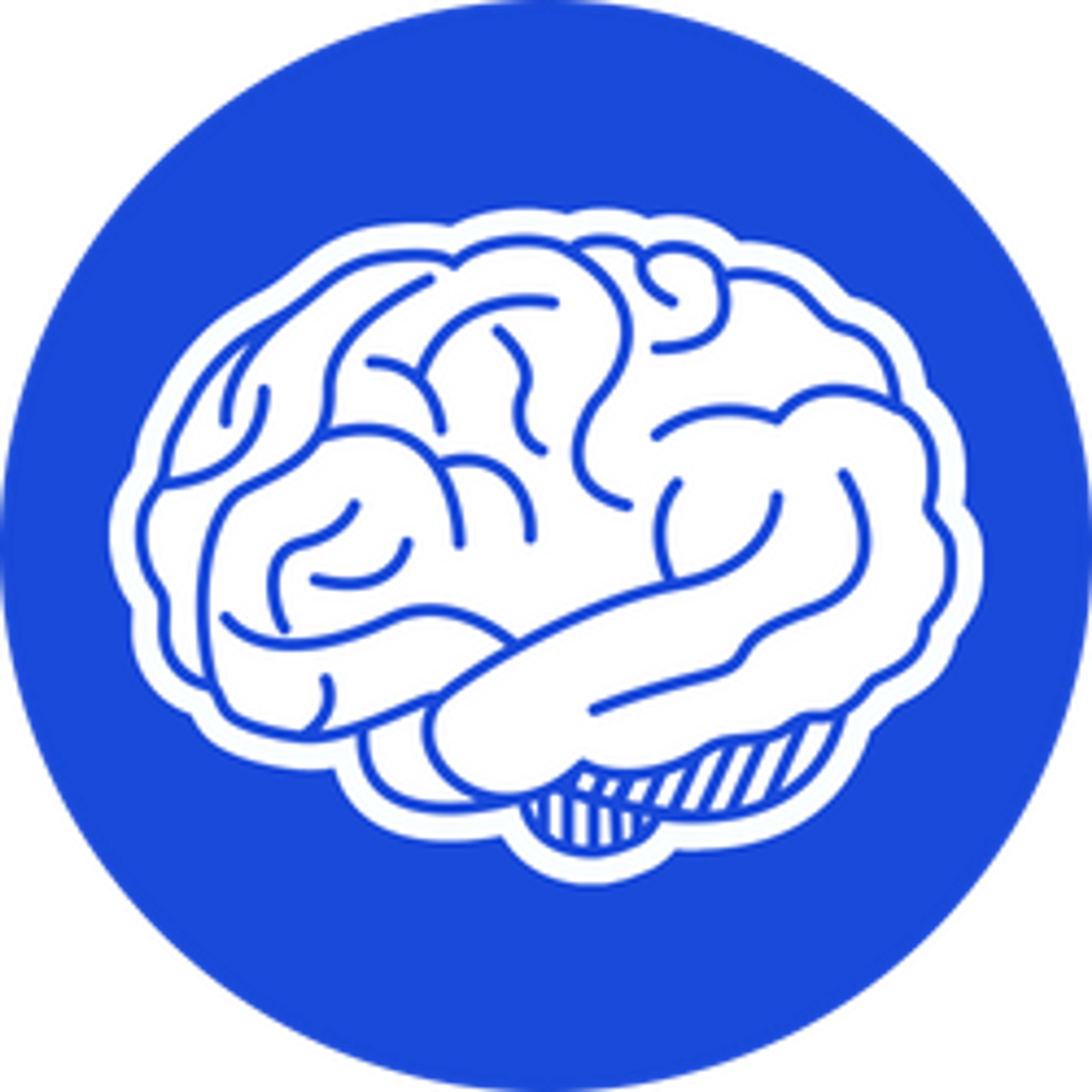Slug
essential-tremor
Video
Category
Movement Disorder
Excerpt
A tremor is an involuntary, rhythmic muscle contraction leading to shaking movements in one or more parts of the body. It is a common movement disorder that most often affects the hands but can also occur in the arms, head, vocal cords, torso, and legs. Tremor may be intermittent (occurring at separate times, with breaks) or constant. It can occur sporadically (on its own) or happen as a result of another disorder.
Authors
Tags
Featured
Featured
Ready to Publish
Ready to Publish
Publish Date
Nov 18, 2022
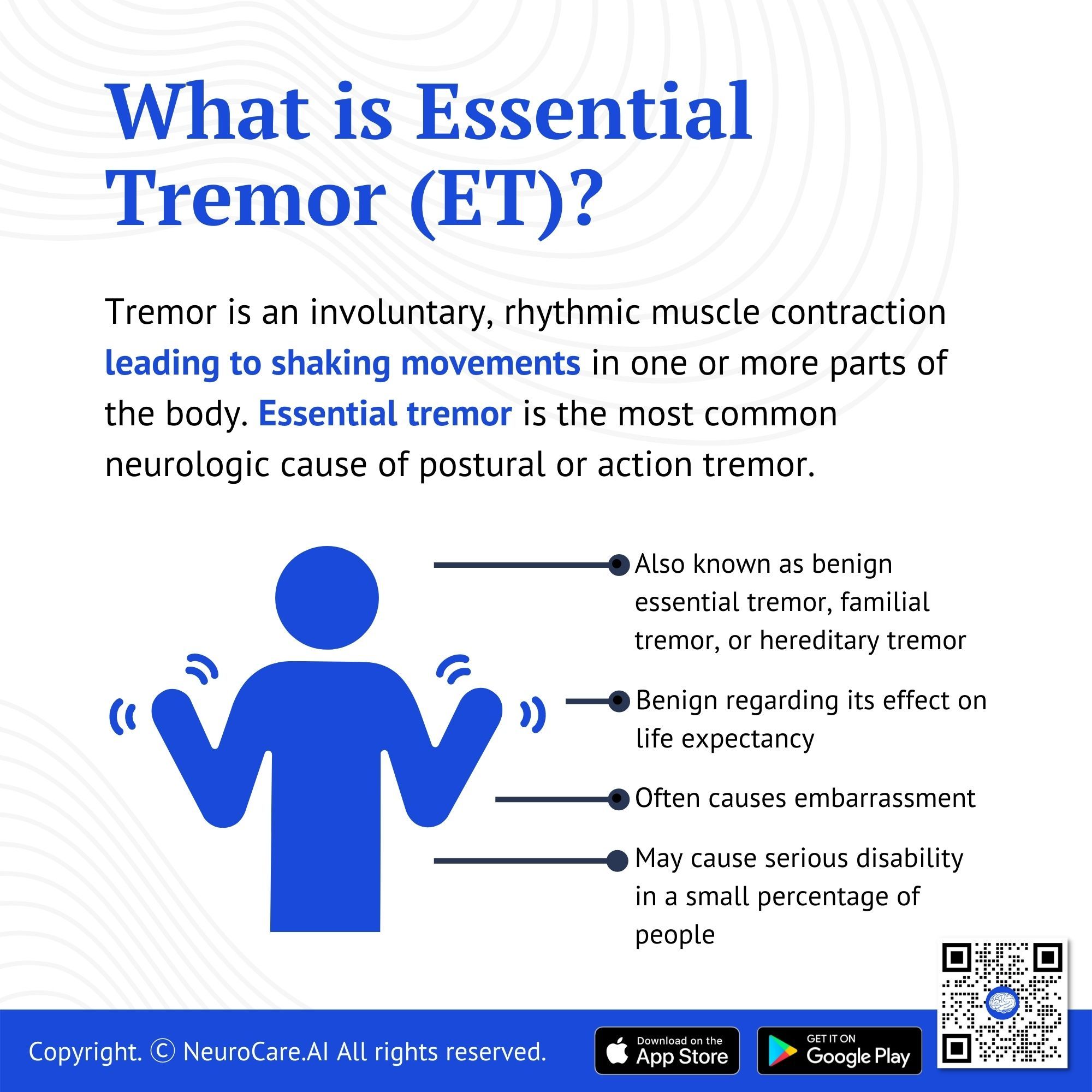
What is an essential tremor (ET)?
Tremor is an involuntary, rhythmic muscle contraction leading to shaking movements in one or more parts of the body. Essential tremor is the most common neurologic cause of postural or action tremor. It is also known as benign essential tremor, familial tremor, or hereditary tremor.
Although benign regarding its effect on life expectancy, it often causes embarrassment and, in a small percentage of patients, also serious disability.
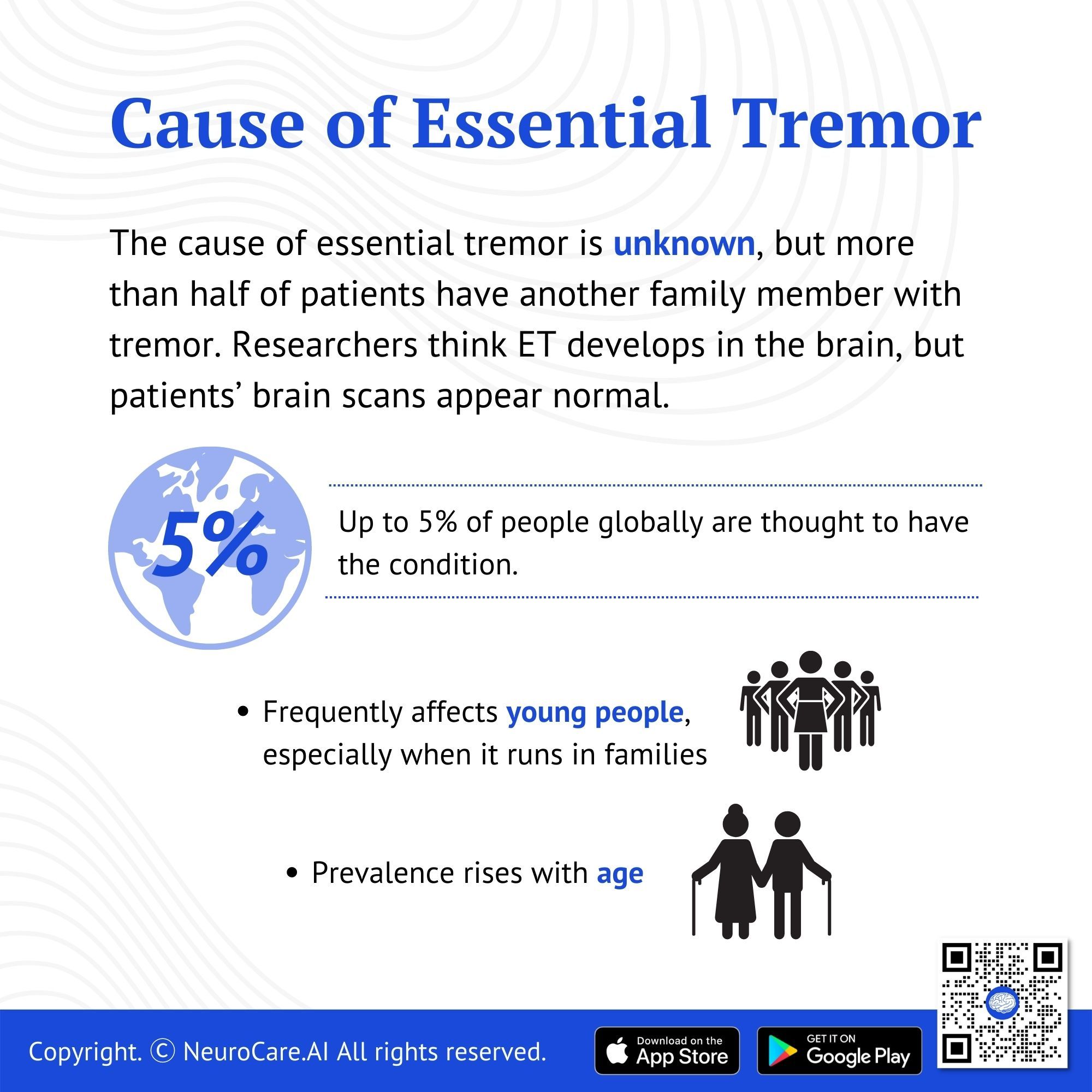
What causes essential tremor?
The cause of essential tremor is unknown, but more than half of patients have another family member with tremor. Researchers have not found the gene(s) that cause ET. For patients with a family history of ET, symptoms tend to begin at an earlier age. Researchers think ET develops in the brain, but patients’ brain scans appear normal. About half of cases of essential tremor seem to be the result of a genetic mutation.
Prevalence of essential tremor
Essential tremor is the most common neurologic disorder that affects postural or action tremors. Up to 5% of people globally are thought to have the condition. Family history can be found in nearly 50% of cases and in 90% concordance in monozygotic twins. Even while essential tremor frequently affects young people, especially when it runs in families, its prevalence rises with age.
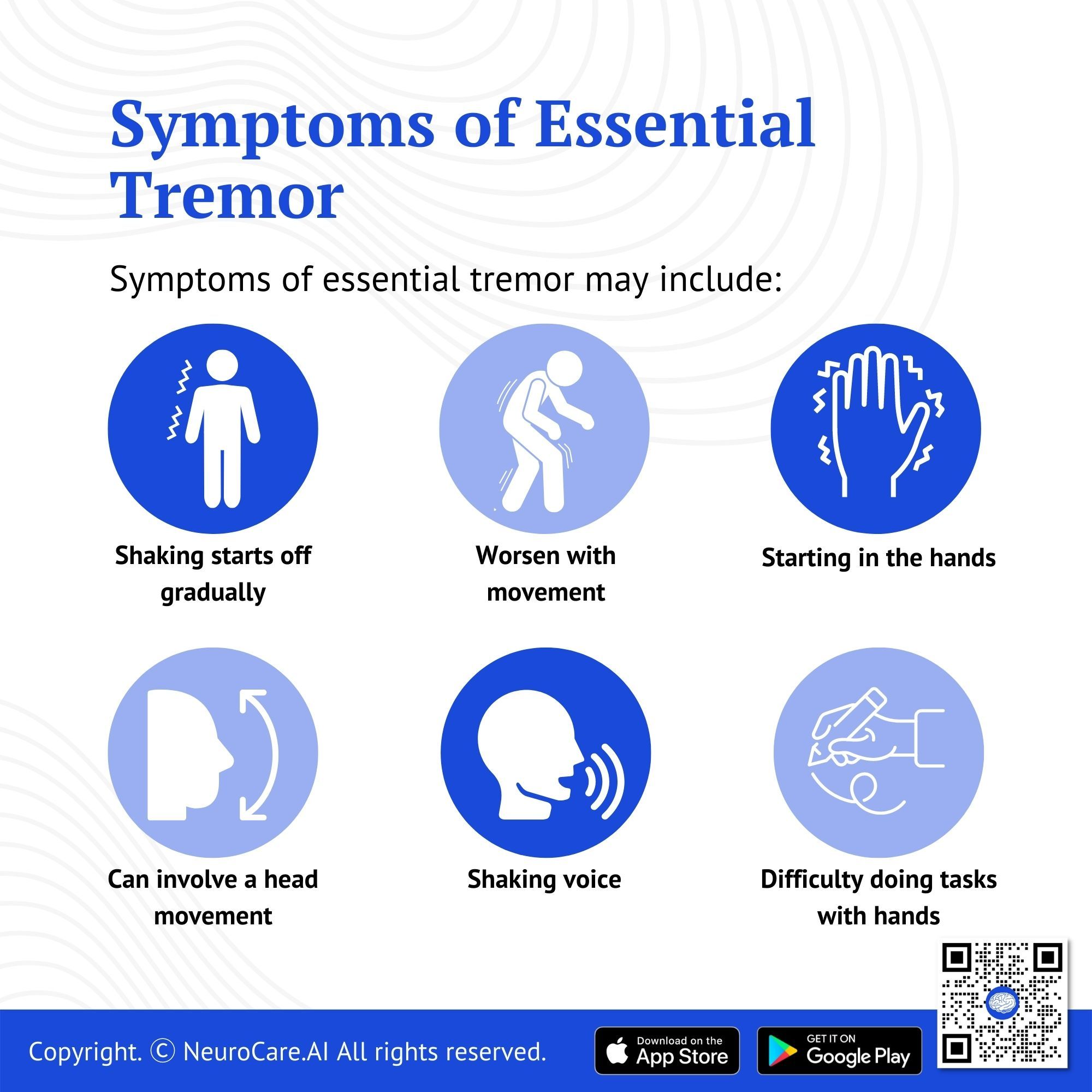
Symptoms of essential tremor
Symptoms are typically progressive and potentially disabling, often forcing patients to change jobs or seek early retirement.
Symptoms of essential tremor may include:
- Shaking starts off gradually, usually focusing more on one side of the body
- Worsen with movement
- Typically starting in the hands, with either one or both hands being affected
- Can involve a “yes-yes” or “no-no” head movement
As the disease progresses, the head and voice may also become affected. The tremors may be aggravated by emotional stress, fatigue, caffeine, or temperature extremes. People with essential tremors may have difficulty doing tasks with their hands, such as writing or using tools.
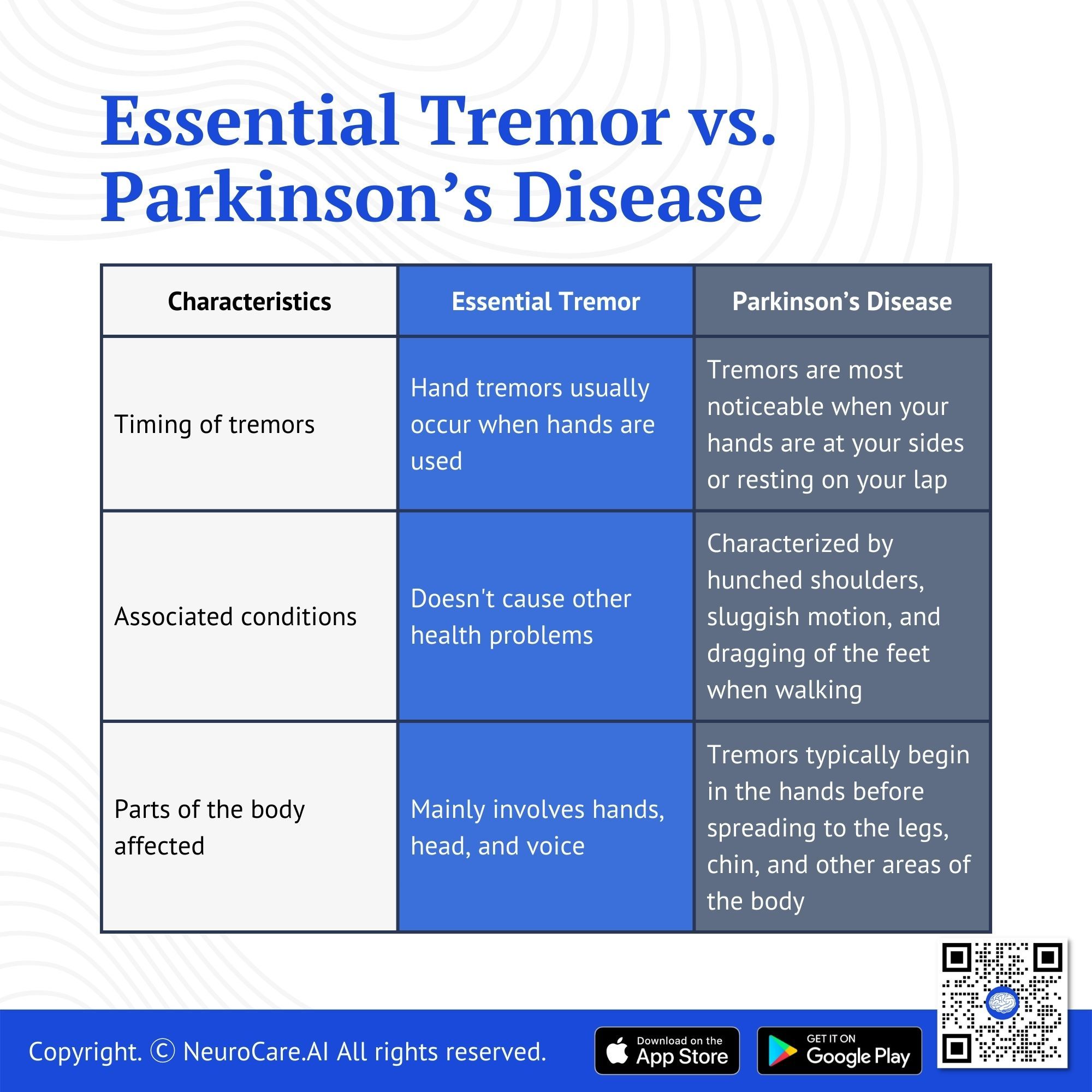
Essential tremor vs. Parkinson’s disease
Many people associate tremors with Parkinson's disease, but there are important differences between the two conditions:
Characteristics | Essential Tremor | Parkinson’s Disease |
Timing of tremors | Hand tremors usually occur when hands are used | Tremors are most noticeable when your hands are at your sides or resting on your lap |
Associated conditions | Doesn't cause other health problems | Characterized by hunched shoulders, sluggish motion, and dragging of the feet when walking |
Parts of the body affected | Mainly involves hands, head, and voice | Tremors typically begin in the hands before spreading to the legs, chin, and other areas of the body |
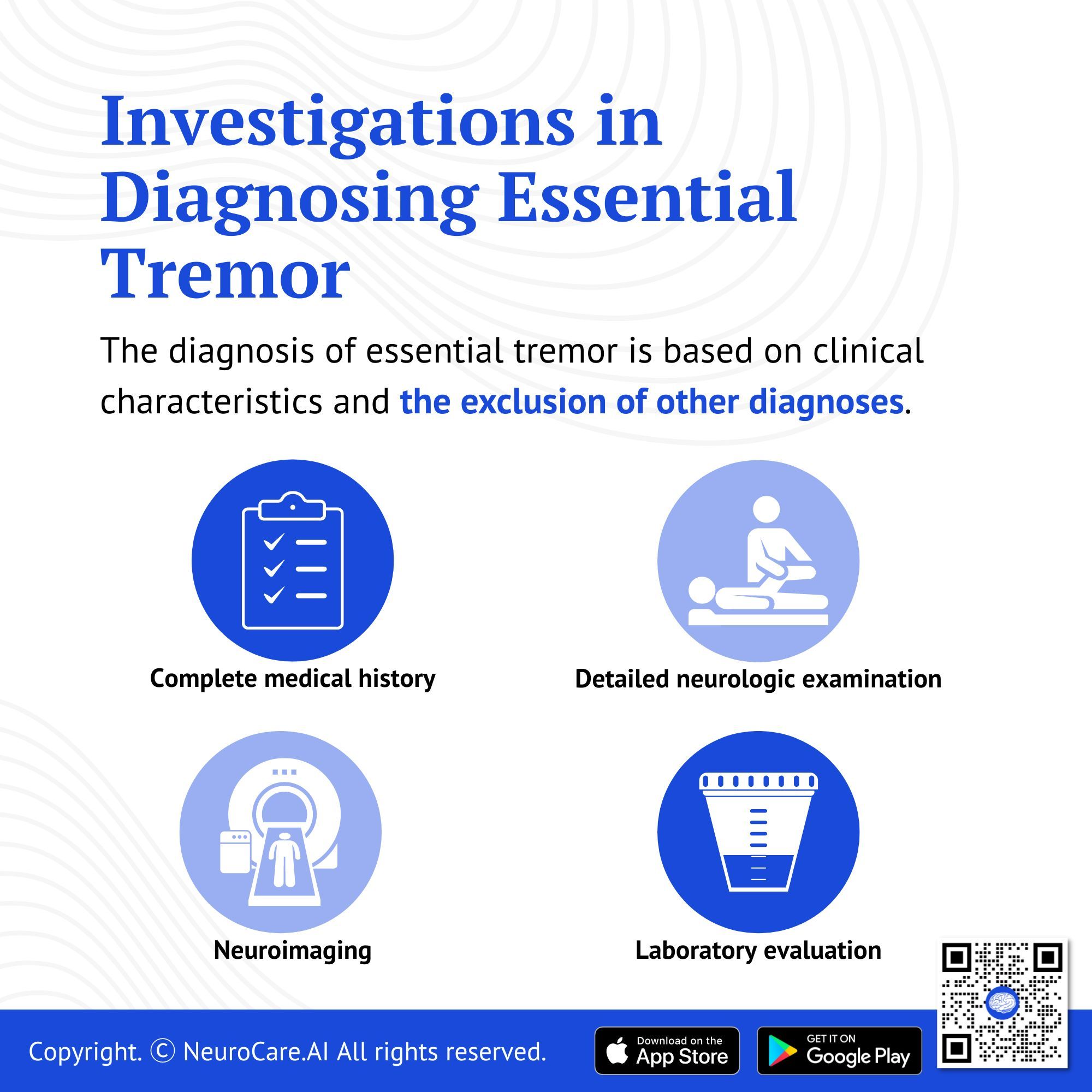
Investigations in diagnosing essential tremor
The diagnosis of essential tremor is based on clinical characteristics and the exclusion of other diagnoses. The core criteria require a bilateral action tremor of the hands and forearms and the absence of other neurologic signs.
- Complete medical history. To rule out the likelihood of enhanced physiologic tremor, a complete list of all medications taken by the patient should be examined. Precipitating, aggravating, or relieving factors such as caffeine, alcohol, medications, exercise, fatigue, or stress should be elicited.
- Detailed neurologic examination. The evaluation relies on a thorough neurologic examination to pinpoint the tremor's precise characteristics, such as its frequency, amplitude, pattern, and distribution, as well as any additional neurologic symptoms that may be present.
- Neuroimaging. There are no specific findings from neuroimaging or other ancillary investigations for confirming the diagnosis of essential tremor, but testing may be necessary to rule out alternative tremor causes.
- Laboratory evaluation. Laboratory tests may include thyroid function, urinary copper, and ceruloplasmin to exclude Wilson disease, and screening for heavy metal poisoning such as lead if any of these causes are suspected.
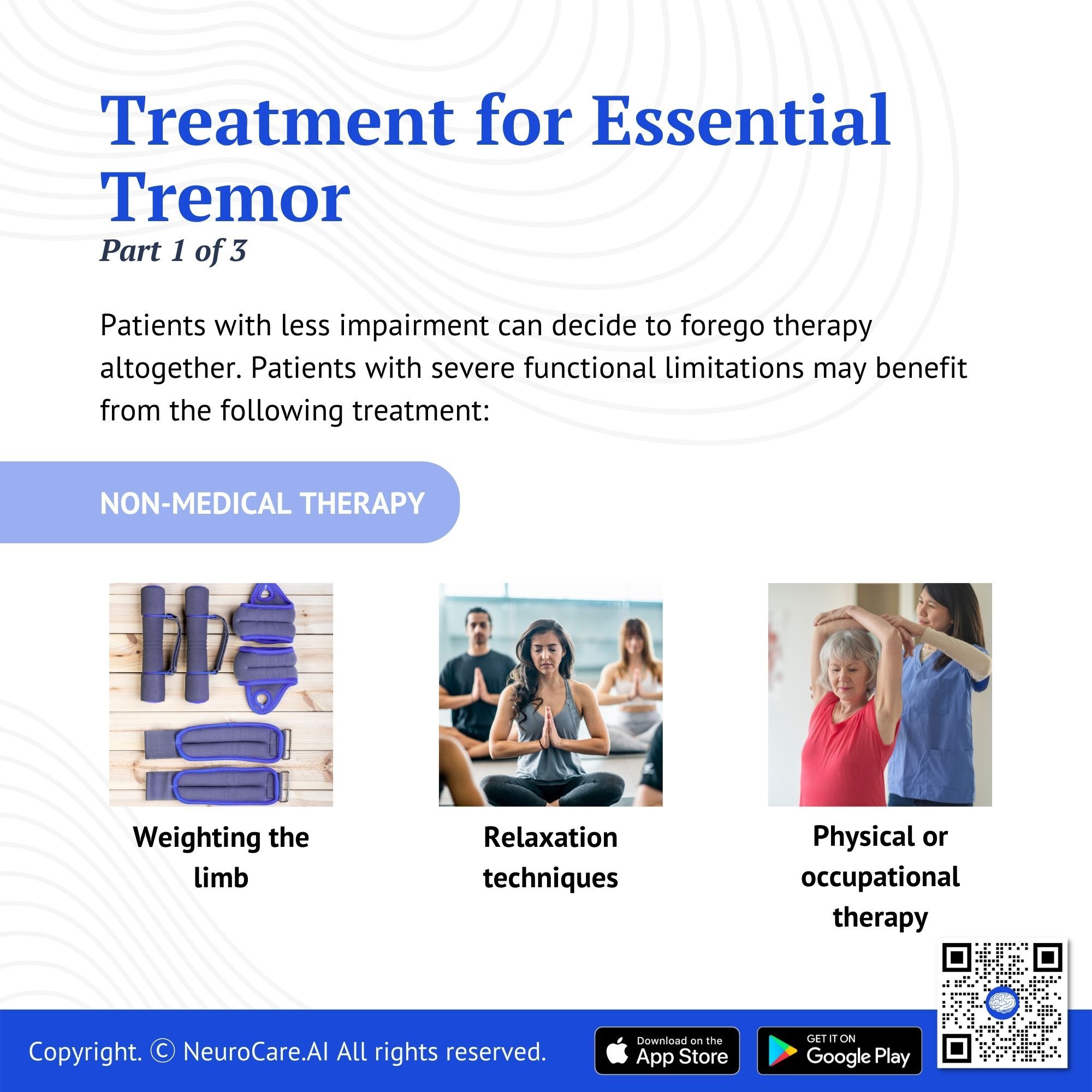
Treatment for essential tremor
Patients with less impairment can decide to forego therapy altogether. Some individuals who do not have functional limitations seek treatment because they find the tremors a significant source of embarrassment. Patients with severe functional limitations may benefit from non-medical, medical, or interventional therapy.
Non-Medical Therapy
Weighting the limb, typically with wrist weights, can help some people with tremors. In a tiny percentage of individuals, this can reduce the tremor enough to provide comfort or improve functioning. Since anxiety and stress classically make the tremor worse, some patients may benefit from non-medical relaxation techniques and biofeedback. Medications known to make tremors worse should be eliminated or minimized when possible. There are commercially available utensil stabilization solutions, such as weighted utensils or active cancelation of tremor technology to suppress tremors, which could be helpful for some patients. Physical or occupational therapy may be advised by doctors. You can learn exercises from physical therapists to improve your muscle strength, control, and coordination.
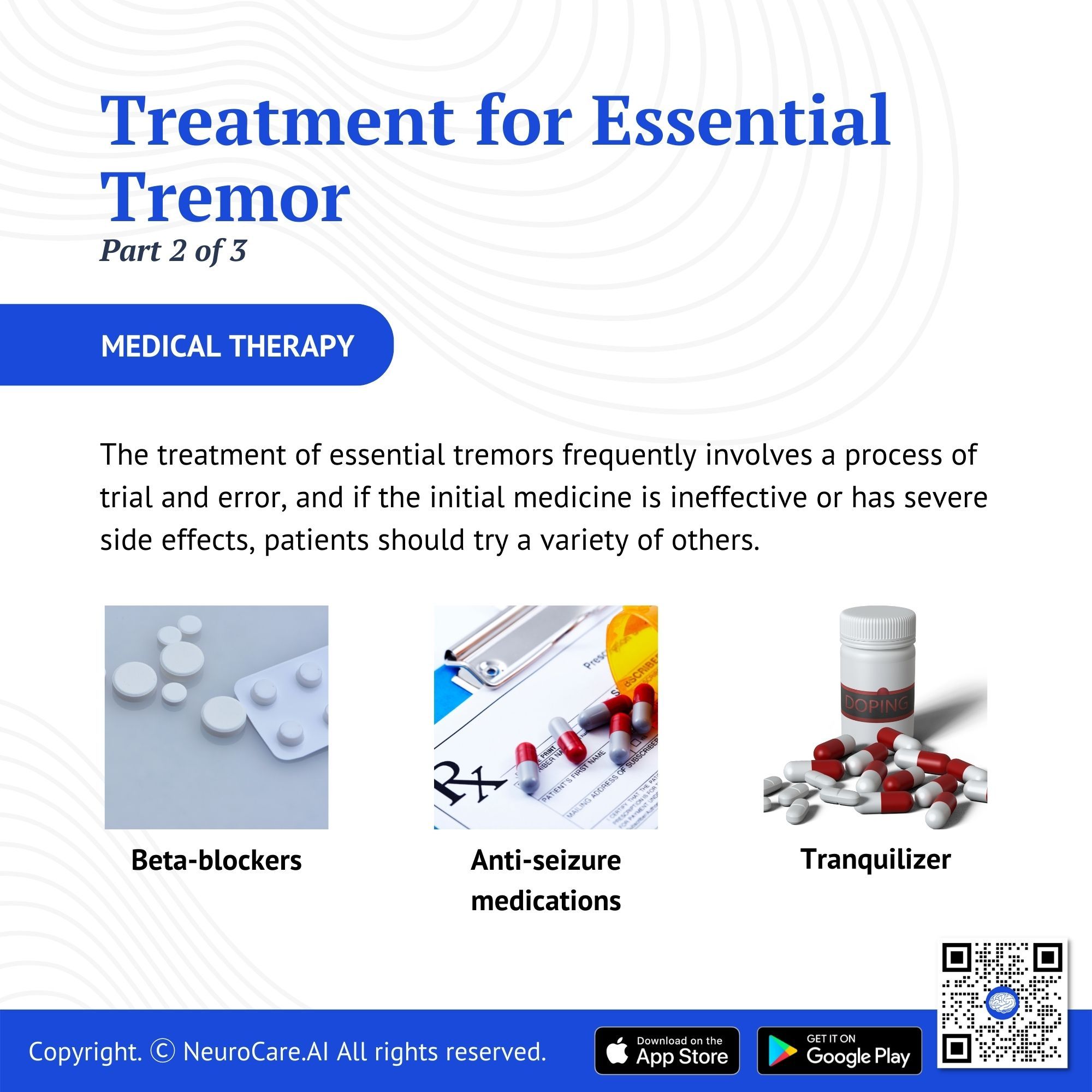
Medical Therapy
The treatment of essential tremors frequently involves a process of trial and error, and if the initial medicine is ineffective or has severe side effects, patients should try a variety of others.
- Beta-blockers. These drugs are frequently prescribed to treat high blood pressure, but help relieve tremors in some people. Examples of this drug are propranolol, atenolol, and metoprolol. For patients with asthma or certain heart conditions, beta-blockers might not be a choice. The side effects could be fatigue, lightheadedness, or heart problems.
- Anti-seizure medications. These medications may help people with essential tremors who don’t respond to beta blockers. An example of this medication is primidone. Other medications that might be prescribed include gabapentin, topiramate, and pregabalin. Side effects include drowsiness and nausea, which usually disappear within a short time.
- Tranquilizers. Doctors may prescribe benzodiazepine medications, such as clonazepam, to patients whose tremors are made worse by stress or worry. Fatigue or slight sedation are examples of side effects.
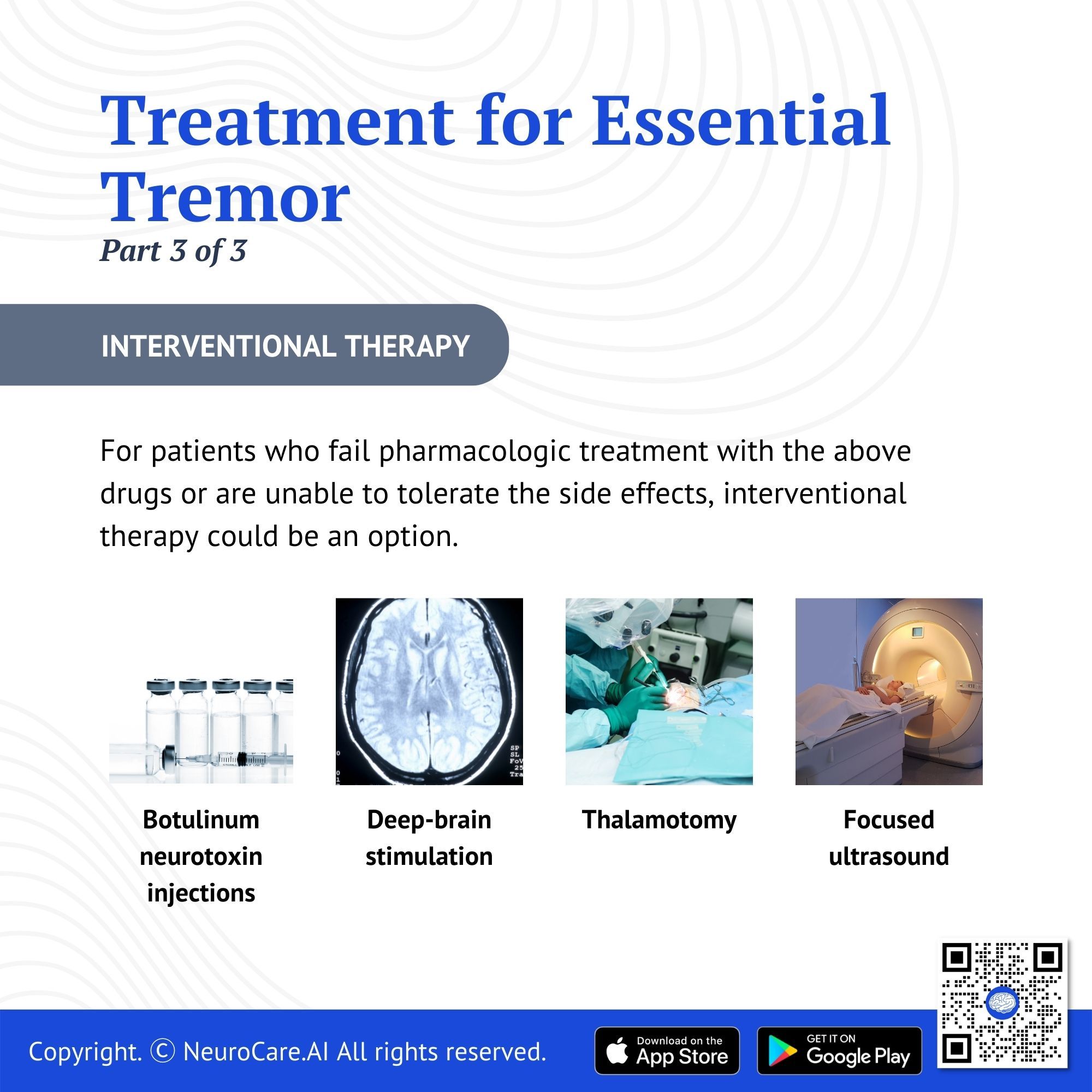
Interventional Therapy
For patients who fail pharmacologic treatment with the above drugs or are unable to tolerate the side effects, interventional therapy could be an option.
- Botulinum neurotoxin (BoNT) injections. Injections of botulinum toxins may be beneficial for some people with severe head or hand tremors.
- Deep-brain stimulation. This is the most common surgical treatment for essential tremors. In deep brain stimulation, an electrode is placed deep within the ventral intermediate nucleus (VIM) of the thalamus to administer electrical stimulation to the brain. Computerized programming of the pulse generator is most commonly done with a handheld device after the patient leaves the hospital to optimize the electrode montage, voltage, pulse frequency, and pulse width.
- Thalamotomy. Stereotactic surgical techniques can create a lesion in the ventral intermediate (VIM) nucleus of the thalamus.
- Focused ultrasound. Approved by the FDA in 2016, magnetic resonance imaging-guided, high-intensity, focused ultrasound thalamotomy is an innovative method for the treatment of essential tremors.
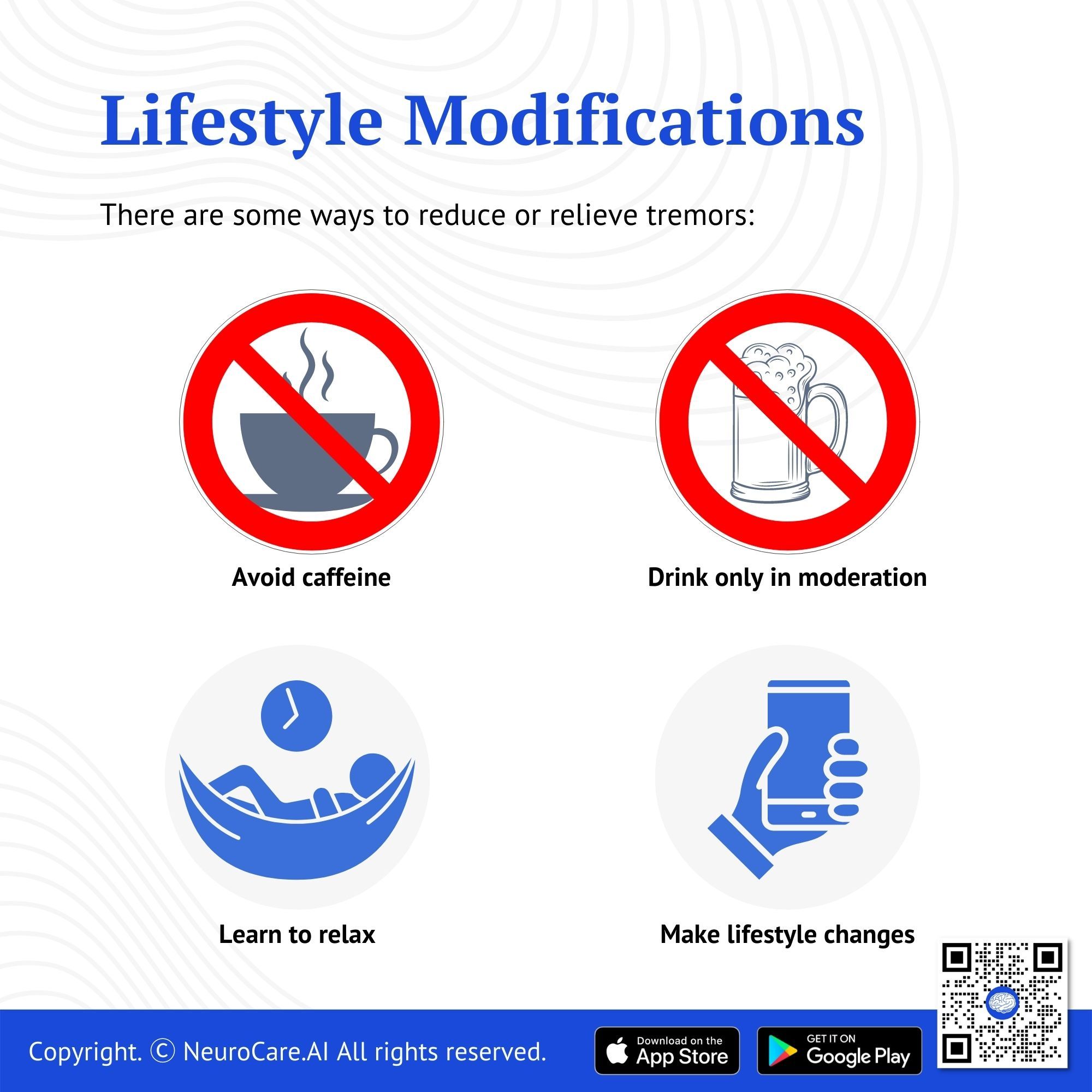
Lifestyle modifications
There are some ways to reduce or relieve tremors:
- Avoid caffeine. Dietary stimulants, such as caffeine, increase tremors.
- Drink only in moderation. Although some people find that drinking alcohol marginally lessens their tremors, alcohol is not a good treatment. Once the effects of alcohol wear off, tremors frequently get worse. Also, greater doses of alcohol eventually are needed to ease tremors, which can lead to alcohol use disorder.
- Learn to relax. Stress and anxiety tend to make tremors worse, and being relaxed may improve tremors. Even while there will always be some level of stress in your life, you may alter how you respond to it by employing a variety of relaxation techniques, like massage or meditation.
- Make lifestyle changes. Use your less affected hand more frequently. Look for alternatives to avoid writing with the tremor-affected hand, such as utilizing debit cards and online banking in place of writing checks.
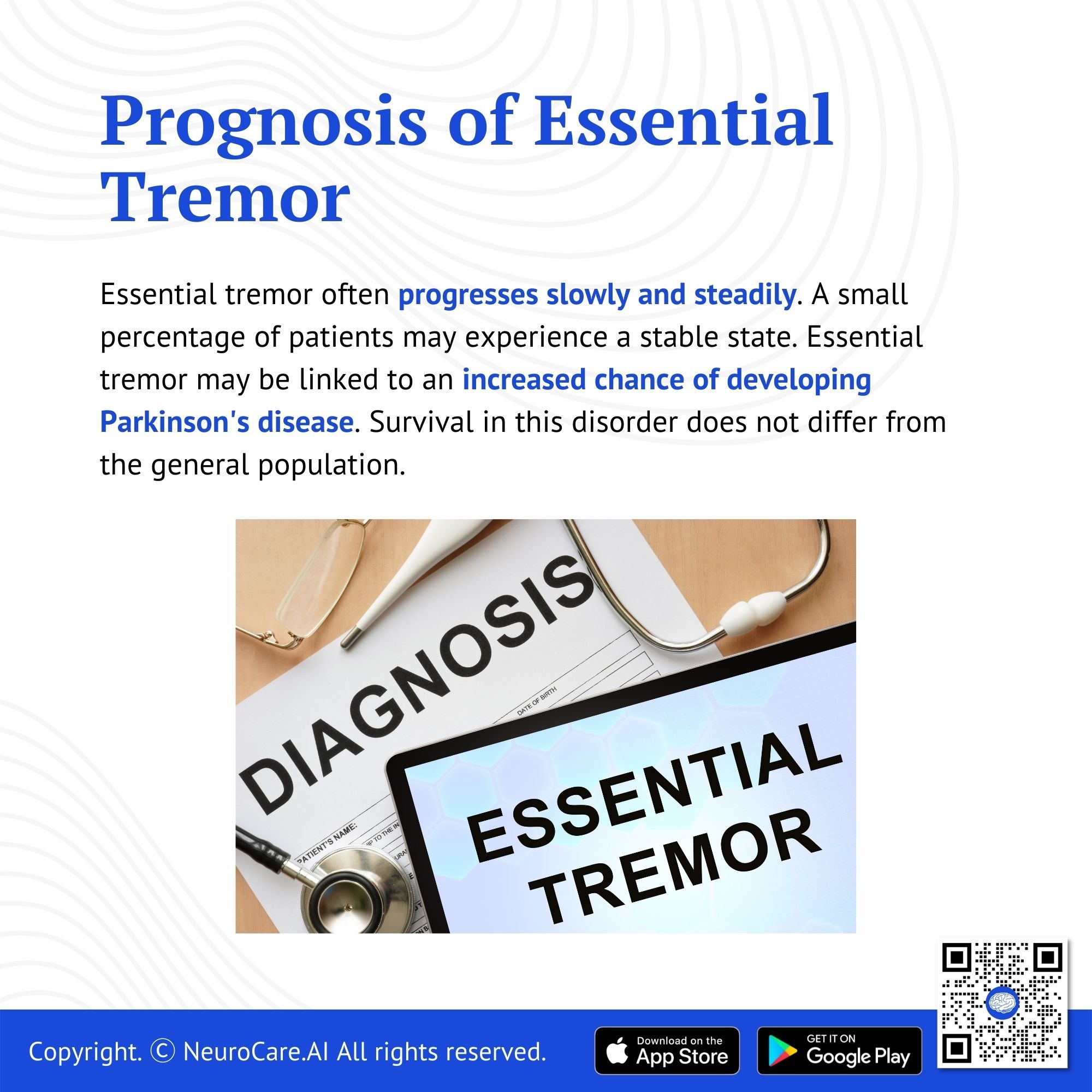
Prognosis of essential tremor
Essential tremor often progresses slowly and steadily. A small percentage of patients may experience a stable state. Essential tremors may be linked to an increased chance of developing Parkinson's disease. Survival in this disorder does not differ from the general population.
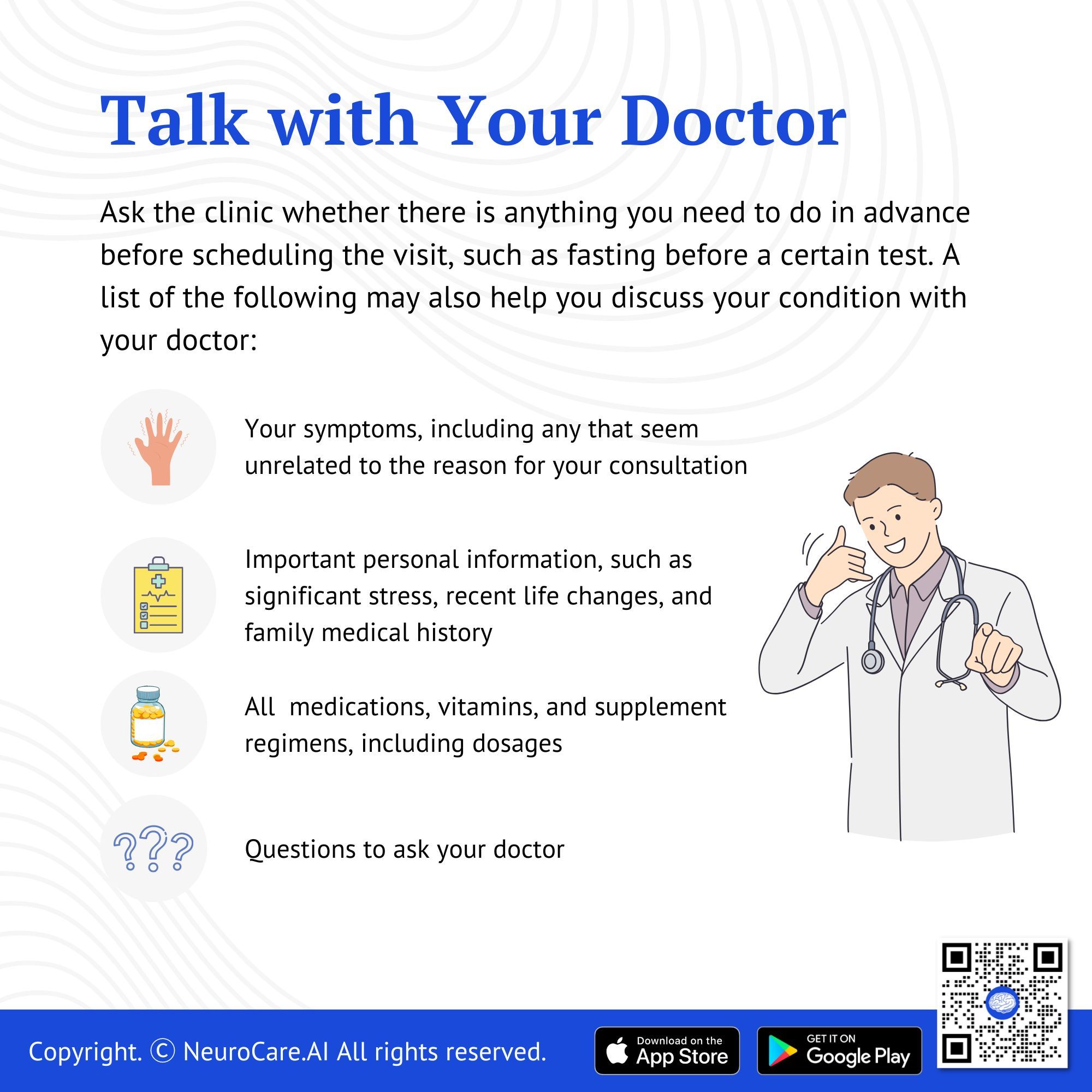
Talk with your doctor
Ask the clinic whether there is anything you need to do in advance before scheduling the visit, such as fasting before a certain test. A list of the following may also help you discuss your condition with your doctor:
- Your symptoms, including any that seem unrelated to the reason for your consultation
- Important personal information, such as significant stress, recent life changes, and family medical history
- All medications, vitamins, and supplement regimens, including dosages
- Questions to ask your doctor
If you can, bring a friend or family member with you to help you remember the information you will be given by your doctor.
Reference:
Agarwal, S., & Biagioni, M. C. (2022). Essential tremor. StatPearls Publishing.
DISCLAIMER:
The information in this document is for general educational purposes only. It is not intended to substitute for personalized medical professional advice. NeuroCare.AI makes every effort to provide accurate and timely information, but makes no guarantee in this regard and disclaims responsibility for adverse consequences resulting from its use. For further information, consult a physician and the organization referred to herein.
AizaMD™: Revolutionizing Clinical Documentation
Discover the power of our ambient clinical documentation system, designed to transform clinical encounters into structured SOAP notes with unmatched ease. Experience exceptional value for less than $3 per day—cheaper than your daily coffee!
- Save Time: Free up over 90 minutes daily for each provider.
- Boost Revenue: Increase daily revenue by at least $1,000 per provider.
- Enhance Coding Quality: Our detailed documentation supports superior coding accuracy, ensuring optimal reimbursement.
- Maximize Engagement and Interaction: Dedicate more time to patient care and less to typing, fostering richer and more effective conversations between clinicians and patients
AizaMD™: Automated Radiology Report Generation!
Discover our breakthrough Radiology AI reporting platform built on Ambient AI. It enhances productivity and minimizes fatigue. Benefit from best-in-class accuracy with our automated radiology report generation, all at market-leading pricing.
📈 Efficiency: Cut dictation times by up to 50% (Less words, More report!
🎯 Focus: Keep your eyes on the images, not the keyboard!
💸 Revenue: Boost revenue by at least 20%
📑 Clarity: Patient summary in plain English
